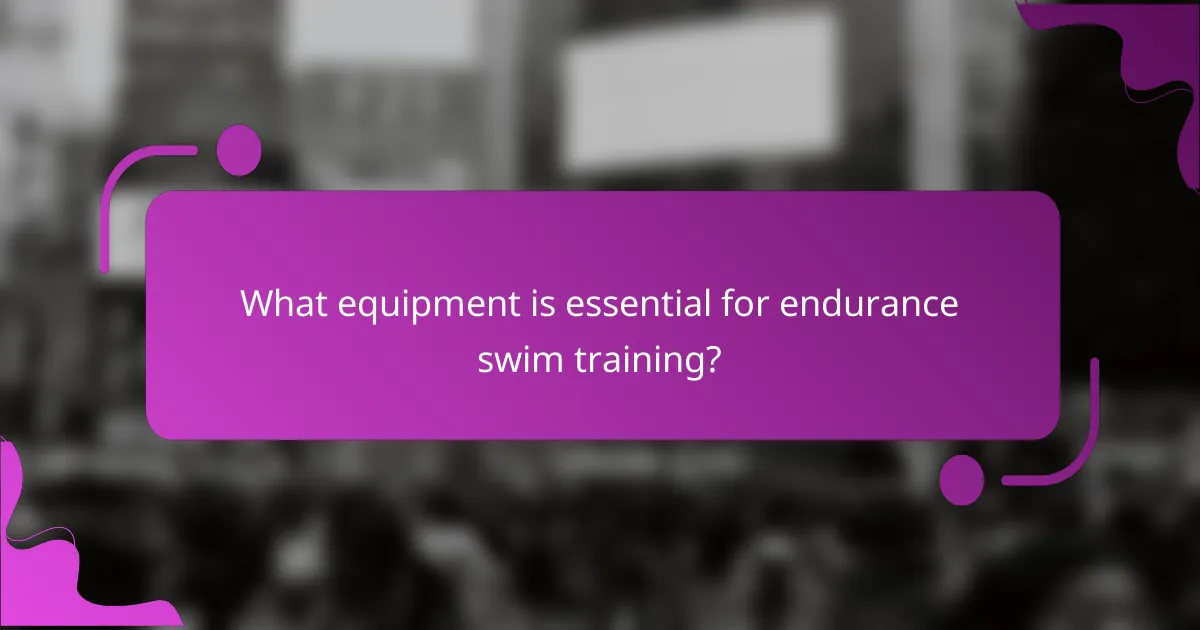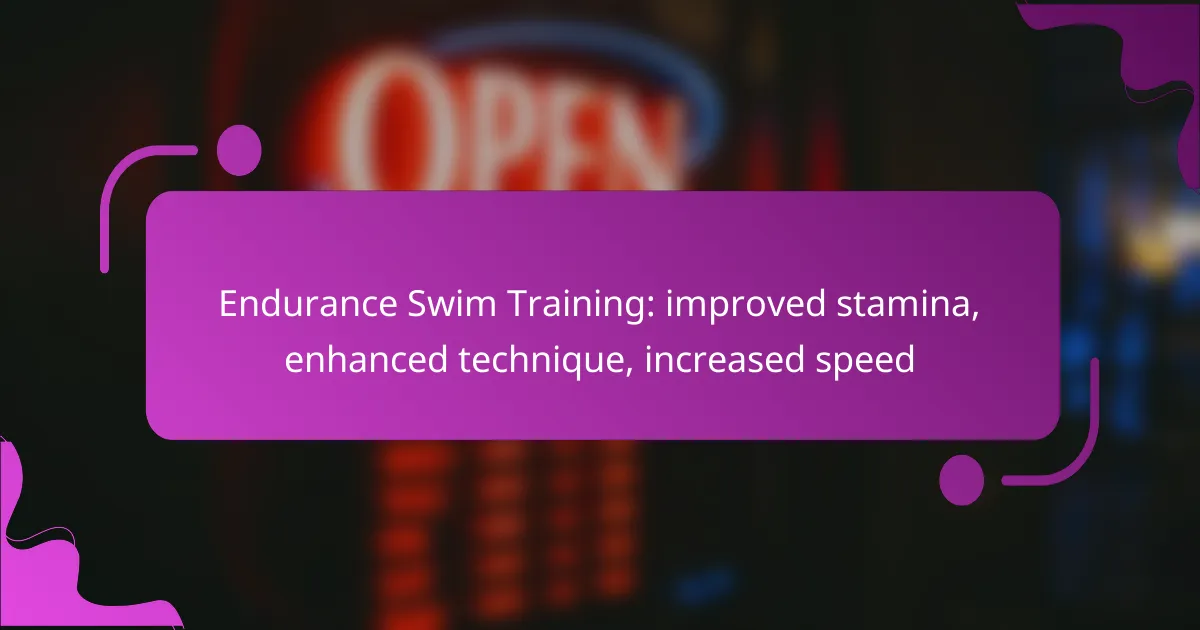Endurance swim training is essential for swimmers looking to improve their stamina, technique, and speed. By focusing on structured workouts and specific techniques, athletes can develop their ability to sustain prolonged activity while enhancing their stroke mechanics and body position. This comprehensive approach not only boosts performance but also leads to faster swim times and greater overall efficiency in the water.

How can endurance swim training improve stamina in Sydney?
Endurance swim training can significantly enhance stamina by developing the body’s ability to sustain prolonged physical activity. In Sydney, swimmers can focus on specific techniques and structured workouts to build their endurance effectively.
Increased aerobic capacity
Improving aerobic capacity is crucial for stamina in swimming. This involves enhancing the efficiency of the cardiovascular system, allowing swimmers to utilize oxygen more effectively during long swims. Regular aerobic workouts, such as continuous swimming at a moderate pace, can lead to noticeable improvements over time.
Swimmers in Sydney can incorporate sessions that last from 30 to 60 minutes, gradually increasing the duration as their fitness improves. This builds a strong aerobic base essential for longer distances.
Enhanced muscular endurance
Muscular endurance refers to the ability of muscles to perform repetitive contractions over an extended period. In swimming, this means maintaining technique and power throughout a race or training session. Specific strength training exercises, such as resistance training or bodyweight workouts, can enhance muscular endurance.
Incorporating exercises like push-ups, pull-ups, and core workouts into a weekly routine can help swimmers in Sydney build the necessary strength to support their endurance goals.
Structured interval training
Structured interval training involves alternating periods of high-intensity effort with rest or lower-intensity swimming. This method effectively boosts stamina by pushing the body to adapt to varying levels of exertion. Swimmers can benefit from incorporating intervals into their training plans.
A common approach is to swim sets of 100 meters at a fast pace, followed by short rest periods. For example, completing 10 x 100 meters with 20 seconds of rest can significantly improve both speed and endurance.
Long-distance swim sessions
Long-distance swim sessions are essential for building stamina, as they simulate race conditions and help swimmers adapt to the demands of endurance events. These sessions typically involve swimming distances of 2 kilometers or more at a steady pace.
In Sydney, swimmers can schedule one long-distance session per week, gradually increasing the distance as their endurance improves. This practice not only builds physical stamina but also mental resilience.
Nutrition strategies for stamina
Proper nutrition plays a vital role in enhancing stamina for endurance swimming. Swimmers should focus on a balanced diet rich in carbohydrates, proteins, and healthy fats to fuel their training. Carbohydrates are particularly important for providing energy during long swims.
Hydration is equally crucial; swimmers should aim to drink water or electrolyte-rich beverages before, during, and after their workouts. A good rule of thumb is to consume around 500 to 750 milliliters of fluids for every hour of training to maintain optimal performance.

What techniques enhance swimming speed in Australia?
To enhance swimming speed in Australia, swimmers should focus on efficient stroke mechanics, streamlined body position, effective breathing techniques, and the use of specific swim drills. These techniques collectively improve propulsion and reduce drag, leading to faster swim times.
Efficient stroke mechanics
Efficient stroke mechanics involve optimizing the way you move your arms and legs through the water. Swimmers should aim for a high elbow position during the pull phase and minimize splashing to reduce resistance. Practicing drills that emphasize proper hand entry and catch can significantly improve stroke efficiency.
Consider incorporating techniques like the catch-up drill, where one arm waits at the front until the other completes its stroke. This helps in developing a more controlled and powerful stroke, ultimately enhancing speed.
Streamlined body position
Maintaining a streamlined body position is crucial for reducing drag while swimming. Swimmers should keep their bodies flat and aligned, with the head in a neutral position to avoid unnecessary resistance. A proper body roll during strokes can also enhance propulsion and speed.
To practice this, swimmers can use a kickboard to focus on their body alignment while kicking. Ensuring that the hips are high in the water can lead to a more efficient swim and improved speed.
Breathing techniques
Effective breathing techniques are essential for maintaining speed and endurance in swimming. Swimmers should practice bilateral breathing to ensure even muscle development and maintain a balanced stroke. Timing breaths with stroke cycles helps to minimize disruption in body position and speed.
Using a rhythmic breathing pattern, such as inhaling every three strokes, can help swimmers maintain a steady pace and avoid fatigue. It’s important to exhale fully underwater to maximize oxygen intake during each breath.
Use of swim drills
Incorporating specific swim drills into training can significantly enhance speed. Drills such as fingertip drag, one-arm swimming, and vertical kicking help to reinforce good technique and build strength. Regularly practicing these drills can lead to noticeable improvements in overall performance.
Swimmers should aim to dedicate a portion of their training sessions to drills, focusing on one or two techniques at a time. This targeted approach allows for better retention of skills and faster progression in speed.

What are the best training plans for endurance swimming?
The best training plans for endurance swimming focus on gradually building stamina, enhancing technique, and increasing speed through structured workouts. A well-rounded approach incorporates various training methods, including consistent weekly schedules, periodization, and cross-training options tailored to individual goals.
Weekly training schedule
A solid weekly training schedule for endurance swimming typically includes 4 to 6 swim sessions, each lasting between 60 to 90 minutes. These sessions should alternate between long-distance swims, interval training, and technique drills to develop different aspects of endurance and speed.
For example, a sample week might include two long swims, two interval sessions, and one technique-focused workout. Incorporating rest days is crucial to allow for recovery and prevent overtraining.
Periodization methods
Periodization involves structuring training into distinct phases to optimize performance and recovery. Common methods include linear, undulating, and block periodization, each varying in intensity and volume throughout the training cycle.
For endurance swimming, a linear approach might start with base-building in lower intensities, progressing to peak training with higher intensities before tapering for competition. This method helps swimmers adapt and improve over time while minimizing burnout.
Cross-training options
Cross-training can enhance endurance swimming by improving overall fitness and reducing injury risk. Activities such as cycling, running, and strength training can complement swim training by building cardiovascular endurance and muscle strength.
Incorporating 1 to 2 cross-training sessions per week can be beneficial. For instance, a cyclist may find that their leg strength and aerobic capacity improve their swimming performance, while a runner can enhance their cardiovascular endurance.
Goal setting for competitive swimmers
Effective goal setting is essential for competitive swimmers aiming to improve their endurance. Goals should be specific, measurable, achievable, relevant, and time-bound (SMART). For example, a swimmer might set a goal to improve their 1500m time by a certain percentage within a few months.
Regularly reviewing and adjusting these goals based on progress can help maintain motivation and focus. Additionally, incorporating both short-term and long-term goals can provide a structured path toward achieving competitive success.

What equipment is essential for endurance swim training?
Essential equipment for endurance swim training includes swim fins, pull buoys, and swim paddles. Each of these tools plays a crucial role in enhancing technique, building strength, and increasing overall speed in the water.
Swim fins for technique improvement
Swim fins are designed to improve your kicking technique and overall body position in the water. They help swimmers develop a more efficient kick, which is vital for maintaining speed over long distances.
When selecting fins, consider the length and stiffness. Shorter fins promote a more natural kick, while longer fins can enhance propulsion but may lead to fatigue. Aim for a balance that allows you to maintain proper form without overexerting yourself.
Pull buoys for upper body strength
Pull buoys are flotation devices placed between the legs to isolate the upper body during swimming. They help swimmers focus on arm technique and build upper body strength without the distraction of kicking.
Incorporate pull buoys into your training by performing sets that emphasize different strokes. For example, use them during freestyle drills to enhance your pull and improve your stroke efficiency. Avoid relying solely on pull buoys, as they can lead to imbalances if used excessively.
Swim paddles for resistance training
Swim paddles increase resistance during strokes, which helps build strength and improve stroke mechanics. By using paddles, swimmers can develop a more powerful pull and enhance their overall speed.
Choose paddles that fit comfortably and allow for a natural hand position. Start with smaller paddles to avoid strain and gradually increase size as your strength improves. Incorporate them into your workouts with caution, as overuse can lead to shoulder injuries.

How does local climate affect swim training in Australia?
The local climate in Australia significantly influences swim training, impacting factors such as water temperature, humidity, and seasonal variations. Swimmers must adapt their training routines to optimize performance and comfort based on these environmental conditions.
Water temperature considerations
Water temperature is a crucial factor in swim training, as it affects both performance and safety. In Australia, water temperatures can vary widely, ranging from cooler southern waters to warmer northern regions. Ideal training temperatures typically fall between 24°C and 28°C, where swimmers can maintain endurance without excessive fatigue.
Training in colder water can lead to muscle stiffness and decreased performance, while overly warm water may cause overheating. Swimmers should monitor water temperatures and adjust their training intensity accordingly. For instance, if the water temperature exceeds 28°C, consider reducing workout duration or increasing rest intervals.
Additionally, acclimatization is key. Swimmers should gradually expose themselves to varying temperatures to enhance their comfort and efficiency in different conditions. This can involve alternating between different training locations or incorporating specific drills that simulate race conditions in warmer or cooler waters.
